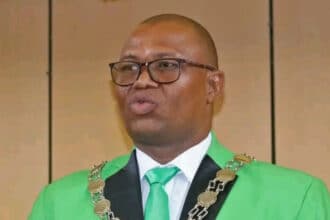Mmadinare village quenches thirst as WUC takes water to the people
With water now available from standpipes across Mmadinare village, it seems like a distant past when former Minister of Minerals and Water Affairs Ponatshego Kedikilwe used to field politically pointed questions on how it could be possible that with a dam in the background, residents could go on and on without a drop to drink.
After the construction of Letsibogo Dam near Mmadinare just over twenty five years ago, Government made a conscious decision that all water from Letsibogo would be ferried straight to Gaborone, the capital city.
That decision did not sound plausible to the people of Mmadinare and the surrounding villages.
That decision made even less sense when it was minister Kedikilwe who had to deliver and explain it to the often perplexed public.
Kedikilwe was Member of Parliament for Mmadinare and a senior member of government.
At the insistence of government, residents had given away their cattle posts and grazing areas all in the hope of accessing water in return. As the years dragged on, those sacrifices seemed to have been in vain.
Almost 25 years later, all the villages of Mmadinare, Sefhophe, Tobane, Damochojenaa, Serule, Gojwane, Moreomabele and Topisi now have access to running water.
It is a new development that for many years had seemed unattainable.
A P1.4 billion loan from the World Bank has made it possible for Botswana government, through Water Utilities Corporation to correct what people from those areas have always perceived as a historic mistake.
The chief Executive Officer at WUC, Gaselemogwe Senai speaks about this project with visible satisfaction.
According to Senai, the recently completed project now delivers water to some forty thousand people on a daily basis.
“This is a huge relief for people of those areas. Water has come after what for them would often have seemed like waiting forever. It has been a long wait. But now they are getting the same quality of water like that in Gaborone. And they enjoy the same water service standards like Gaborone,” says Senai in an interview with The Voice Newspaper.
While water is now available where there was none before, Senai admits that it has not been all smooth sails.
He says WUC has had to contend with the fact that the villages have grown over the years and as a result there are households that are not serviced by existing internal pipe networks.
Above that, the existing networks have been adequate in withstanding to new water pressures.
As a result WUC needs to constantly work on remedying the burst pipes inside these villages, he says.
At over 80 percent capacity, Letsibogo dam has sufficient water to go on for over 2 years without rain.
Senai adds that there used to be a time when Letsibogo was the only dam feeding into the North South Carrier.
Now there is Dikgatlhong dam as well.
Other than servicing the village surrounding Mmadinare, Letsibogo dam is also dedicated to the huge citrus project near Selibe Phikwe, a prized economic diversification flagship for Botswana government.






